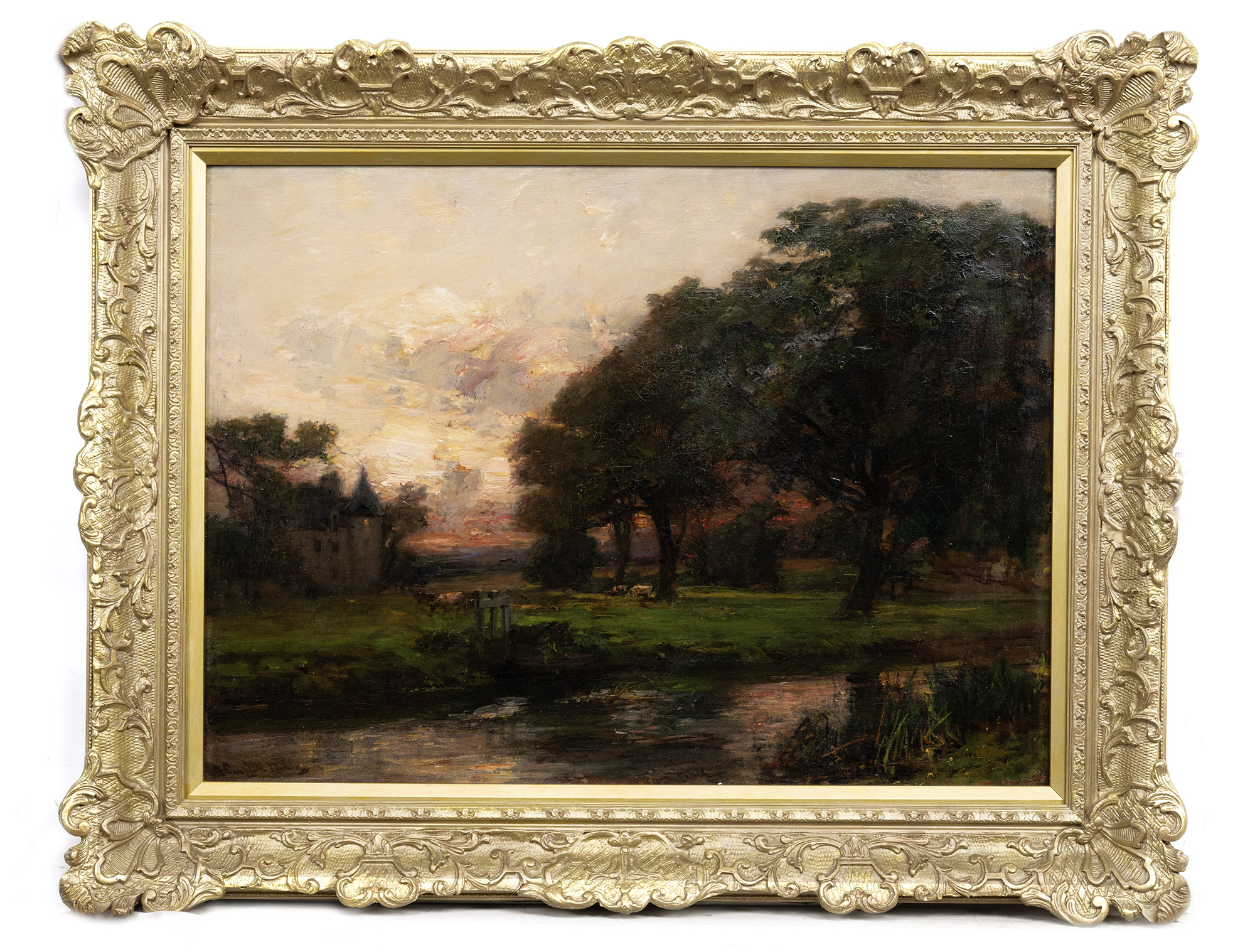oil on canvas, signed framed image size 57cm x 77cm, overall size 76cm x 96cm Partial handwritten label verso Note: RSA Obituary by James Guthrie RSA. Transcribed from the 1913 RSA Annual Report: The death of James Campbell Noble, on 25th September, removed from the Academy’s active list the name of one of its most widely known members. Born in Edinburgh on the 22nd of July 1845, Mr. Noble’s earliest association with art, like that of Sir George Reid, was in the department of lithography. As a lad of fifteen he entered the employment of Mr. J. O. Brown, a well-known exponent of that branch of engraving, where he was engaged mainly on architectural subjects; and when after four years, his master retired from business, young Noble continued his vocation on such work as came to hand, illustrating in this way several volumes on anatomical and surgical subjects. During those years he attended the Trustees’ School of Design and, later, the Academy’s Life Class, where he carried off more than one of the leading honours, including the Keith prize in 1873. It was as a figure painter that Mr. Noble first came before the public, and his contributions to the Exhibition commence in 1869, with a picture entitled “ Watching Conspirators.” For some years his exhibits are few and intermittent, but from 1873 onwards he is a regular and copious contributor, and till towards the close of that decade figure subjects predominate. “ Near the end of the Weft” (1875), and “The Duet (1879), are typical of the period. About the later seventies, however, a change of motive and direction is visible, when, under the influence of the pleinair movement then beginning to assert itself in Scotland, he turned, like several of his contemporaries, to those problems of light which are most readily dealt with under the open sky. For a while harbour and shipping subjects furnish themes for the broader treatment implied in the change; these he found on our rivers and estuaries from the Forth to the Thames and Medway. One or two visits to the Berwickshire coast during the earlier ’eighties gave a more local and individual turn to his work, and from that time till nearly the close of the century, during which Mr Noble made Coldingham his home, his pictures are mostly associated with that village and neighbourhood. Many of them illustrate the sea-faring and fisher-life of that rockbound coast, as witness such titles as “The Fisherman’s Return” (1883), “The Signal of Distress” (1888) and “Making for Harbour” (1893). But far from confining himself to sea or shore, he draws largely for subject-matter on the agricultural and historic interest of the adjacent districts, with occasional flights to more distant sketching grounds. But the outstanding feature of Mr. Noble’s art career is the virility of his later work. At a period of life when new developments, either of technique or outlook are rare, moved, perhaps, by a visit to Holland about the close of the century, his art shows a distinct advance in both spheres ; and this quickening of his powers was maintained to the end. During these last years Mr. Noble portrays with equally facile brush the barge-thronged rivers of the Low Countries and the romantic scenery of the Highlands. Something of temperamental affinity seemed to be drawing him strongly towards the latter class of subjects; and it was during a visit to the land of the Campbells that he was prostrated by the illness which, after a few days, proved fatal. Always keenly interested in the work of his juniors, Mr. Noble had for many years been a visitor at the Academy’s Life School and School of Painting, where his strong personality and sympathetic temperament gave him a unique position amongst a long succession of students, by whom, in after years, his advice and encouragement were highly valued. He was a power also in the social life of the art community and served for the full term of office as President of the Scottish Arts Club. His intimate relations with the musical membership of the club peculiarly fitted him for such a position, and, in conjunction with his personal accomplishments in that direction, made his name a household word in the wider social life of the city. Though he never took a very prominent part in debate, the influence of his wide and varied experience made itself felt in many ways at the Council Board of the Academy. Beyond the membership of the Academy your Council regret to record the deaths of two distinguished painters whose works have frequently lent interest to the Exhibitions of recent years. Mr. Joseph Crawhall, a native of Northumberland, who had attained to great eminence as an animal painter; and M. Gaston la Touche, whose romantic treatment of subjects in various genres had given his work a unique position in contemporary French Art.
Viewing is by online catalogue only.
McTear's require photographic ID from every client before purchased goods can be released.
The sale ends on Sunday 13th July at 7pm. Payment is due by Tuesday 15th July at 5pm. All lots purchased must be collected by Friday 18th July at 3pm.
Buyer`s Premium 24% + VAT
Lots purchased online with the-saleroom.com will attract an additional charge for this service in the sum of 4.95% of the hammer price plus VAT at the rate imposed
Please be advised if you do not meet the reserve your bid will still stand if the vendor accepts your offer.
Shipping
For other purchases we recommend packing and shipping companies such as:
Collin Moran & Son
collin@collinmoranandson.co.uk
0141 849 1947
Mailboxes
info@mbewoodlandsroad.co.uk
0141 332 6555
admin@mbeshawlands.co.uk
0141 649 6777
Aardvark Art Services Ltd (Specialist Painting Couriers)
info@aardvarkartservices.com
01253 794673
Alban Shipping
info@albanshipping.co.uk
01582 493 099
To view McTear's Terms of Business click here.
To view McTear's privacy policy click here.
See Full Terms And Conditions





